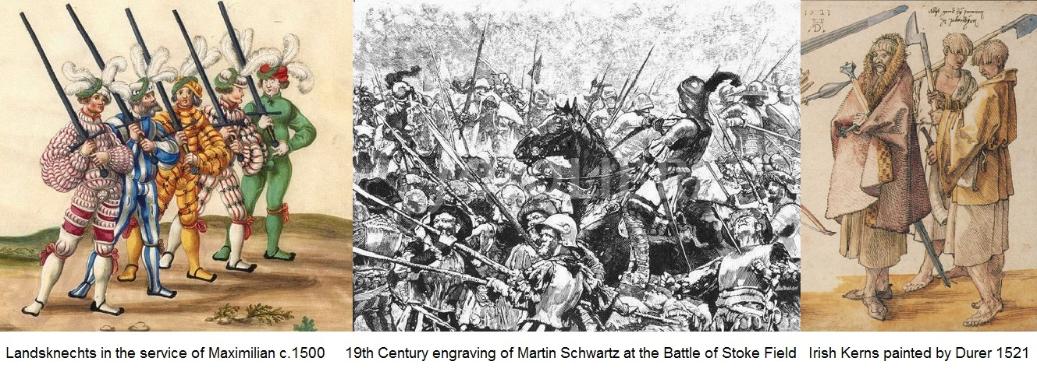WILLOWS & ROSES – THE LIFE & DEATH OF MARTIN SCHWARTZ
On the 16th of June 1487 Henry VII defeated a Yorkist army at the Battle of Stoke Field (near Newark) and among the dead was Martin Schwartz, one of the most celebrated mercenary captains of his day. So how did this German soldier-of-fortune come to perish in a doomed rebellion against the House of Tudor? Schwartz was born sometime around 1450 in the German city of Augsburg. His father was a shoemaker but his son was destined for something greater than the cobbler’s last.
Like many ambitious young men in the late Middle Ages, Schwartz was determined to win wealth and fame with his sword and the constant wars fought by the crowned heads of Europe offered plenty of opportunity. Schwartz first comes to notice at the Siege of Neuss [1474-75] where Charles the Bold Duke of Burgundy was vying with the Frederick III Holy Roman Emperor for control of the Rhine. Charles besieged Neuss with a mercenary army that included a contingent of English archers ( who mutinied when their pay failed to materialise) and the young Martin Schwartz.
At Neuss Schwartz was on the losing side but a decade later he’d turned his coat and was fighting for the new Holy Roman Emperor Maximilian of Hapsburg. This is not entirely surprising as Maximilian had married Charles the Bold’s daughter and, when his father-in-law was killed at the Battle of Nancy [1477], the Duchy of Burgundy had become part of Maximilian’s Empire. However, German rule in Burgundy and Flanders was repeatedly challenged by the kings of France and their subsequent wars provided yet more employment for mercenaries like Martin Schwartz. After distinguishing himself in several battles with the French, Schwartz was knighted by Maximilian and like many mercenary ‘landsknechts’ of the time he spent his new found wealth on outrageous clothes and jewels.
Chroniclers of the time record that Maximilian’s jesters frequently poked fun at Schwartz’s outlandish taste in clothes but his manner of dress was not mere vanity. As a mark of his gratitude, Maximilian had exempted his mercenaries from the sumptuary laws that regulated what common people could wear.
Schwartz’s regular attendance at Maximilian’s court brought him into contact with another powerful player in late 15th Century politics Margaret of York who was both the widow of Charles the Bold and the sister of two English kings: Edward IV and Richard III. Margaret was determined to avenge her brother Richard’s death at the Battle of Bosworth, and restore the House of York to England’s throne, and she chose Schwartz to lead a contingent of German and Swiss mercenaries that would form the backbone of a new Yorkist army.
Margaret had become convinced that a baker’s boy named Lambert Simnel was Edward V, her long lost nephew and one of the ‘Princes in the Tower’ who’d disappeared in 1483. Together with two Yorkist exiles, John de la Pole Earl of Lincoln and Viscount Lovell (made famous by the scurrilous rhyme “The Cat, the Rat and Lovell our dog rule all England under a hog”), Margaret planned to place Lambert on the throne and in 1487 the White Rose bloomed once more.
The Yorkists raised their standard in Ireland, where support for the White Rose was still strong, on the 4th May 1487 and crossed over to England a month later. Besides the English retainers mustered by their lords, the invading army was a curious mix of Schwarz’s 2,000 Germans/Swiss landsknechts and 4,500 Irish ‘kerns’. The Germans were dressed in their famously gaudy striped hosed and slashed doublets and were armed with 18 foot long pikes or double handed swords. By contrast the kerns wore nothing but loose tunics and were armed with short javelins.
After landing near Barrow-in Furness the Yorkist army marched south but, like so many rebellions before and since, the expected rising of the local populace never materialised. The lack of local support outraged Schwartz and his protest to the Earl of Lincoln is recorded in the contemporary Chronicle of London:
“Sir I now see well that ye have deceived yourself and also me but, that notwithstanding, all such promise I have made unto my lady [Margaret] the duchess I shall perform.”
Schwartz was as good as his word and he remained with the Yorkist army to the bitter end. The fighting at Stoke Field was as ferocious as any in the Wars of the Roses and even though many of the Schwartz’s landsknechts carried the new handguns it was the English longbow that proved decisive. The Germans and Irish were decimated by the Tudor army’s archers and the Burgundian chronicler Jean Molinet tells us that the bodies of the fallen were "filled with arrows like hedgehogs”. Even today the little stream where the Yorkist army made its last stand is known as the Bloody Gutter.
Simnel, being little more than boy at the time, was pardoned and Lovell may have escaped (though he was never heard of again) but John de la Pole and Martin Schwartz were killed. According to legend they were buried with stakes of willow driven through their mutilated corpses and a peaceful grove of willow trees marked their graves until the early 19th Century.
The last Yorkist/de la Pole attempt to depose the Tudors forms the setting for The Devil's Band, to order click here
